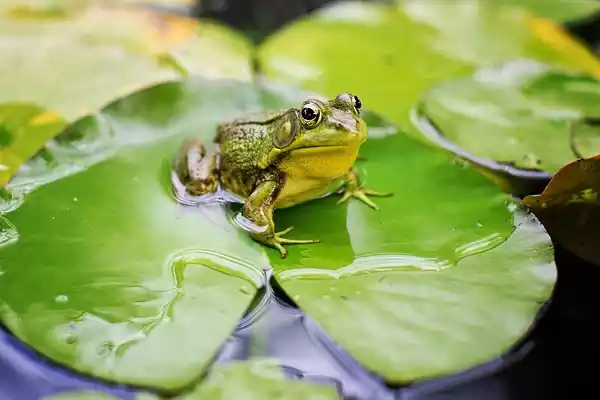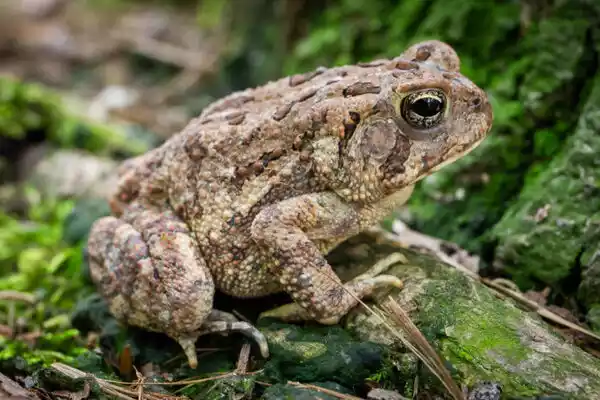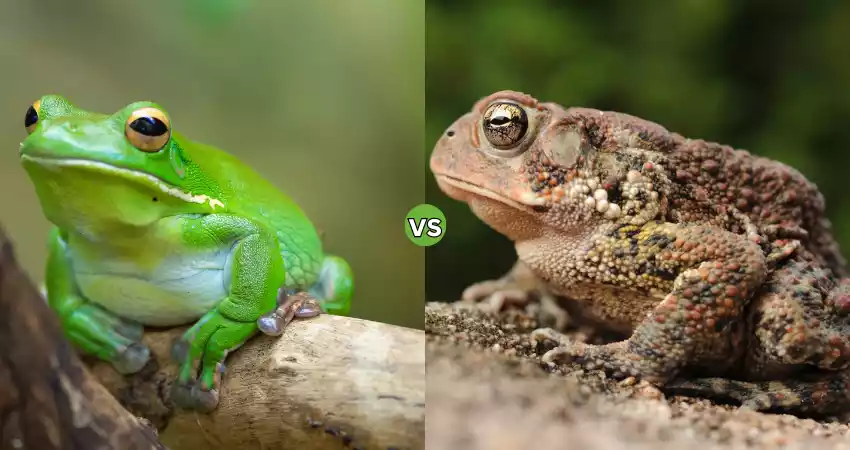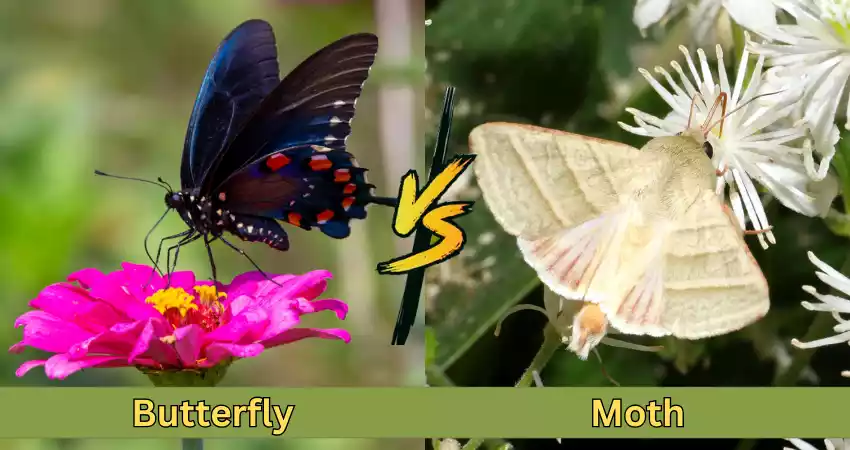What is the Difference Between Frog and Toad
Frog and Toad, often grouped together due to their similar appearances, belong to the fascinating world of amphibians. While sharing some commonalities, these creatures possess distinct characteristics that set them apart.
Exploring their differences in physiology, behavior, habitat preferences, and ecological roles sheds light on their unique adaptations and evolutionary paths within the diverse realm of amphibious life.
Frog
A frog is one of the species of amphibian in the order Anura which is characterized by a soft, moist skin with long hind legs, designed for jumping, and bulging eyes, and usually living in semi-aquatic or aquatic habitats.
Frogs are famous for their unique life cycles that begin as a larva of the aquatic (tadpoles) and then undergo metamorphosis to become adults. They vary in size, coloring, and habitats, spanning diverse continents with the exception of Antarctica.

Frogs play an important role in ecosystems as predators and prey. They are also instrumental in reducing the population of insects and being indicators of the health of the environment because of their vulnerability to habitat and pollution.
Toad
Toads are a species of amphibian like a frog which is part of the family Anura. Toads have rough, dry, or warty skin, as compared to the soft and wet skin of Frogs. They usually have smaller hind legs that allow them to walk instead of jump like Frogs.
Toads prefer dry environments to frogs and are found in various habitats, such as grasslands, forests, and even gardens. The eggs they lay are laid in large chains, rather than in groups like frogs.

Toads, just like frogs transform from tadpoles into adults. They play an essential role in ecosystems by eating insects and acting as predators and prey, adding to the stability of many ecosystems.
Ecological Importance
Toads and frogs have immense ecological significance in various ecosystems. They are predators and are essential in limiting the population of insects and helping to ensure the balance of nature.
Their diet, mostly comprised of insects, aids in the control of mosquitoes and agricultural pests. Additionally, amphibians act as prey to a variety of predators, thereby enhancing the food chain and biodiversity.
In addition, due to their vulnerability to environmental change and pollution, frogs and toads function as bioindicators, indicating the state of the ecosystem. The decline in their population could be a sign of underlying environmental issues and their protection is crucial to ensure the wellbeing of ecosystems around the world.
Similarities – Frog and Toad
The frogs as well as toads, which both belong to the Anura order, Anura have many similarities:
- amphibious Nature Frogs as well as toads can be classified as amphibians which means they spend a portion all their time in water, and some on land.
- The Life Cycle They go through similar life cycles, beginning as eggs in the water that transform into tadpoles. They then change into adult forms.
- Food habits Toads and frogs are carnivores, primarily feeding on insects as well as other invertebrates.
- The importance of ecosystems They play vital functions in ecosystems, controlling insect populations as well as serving as food for predators of various species.
- environmental sensitivity Both species are prone to changes in the environment, which makes them indicators of the health of the ecosystem.
- Breathing They both have permeable skin, which aids in respiration, in addition to the lungs.
Comparison chart of Frog and Toad
Here’s a comparison chart highlighting the differences between frogs and toads:
| Characteristics | Frogs | Toads |
|---|---|---|
| Skin Texture | Smooth, moist | Rough, dry or bumpy |
| Body Shape | Slender with long legs | Squat with shorter hind legs |
| Habitat Preference | Typically near water bodies | Diverse habitats, often drier areas |
| Egg Clustering | Laid in clusters | Laid in long chains or strands |
| Movement | Good jumpers; move by hopping | Walk or crawl instead of hopping |
| Voice | Typically produce melodic sounds | Often produce a harsher, croaking sound |
| Eyes | Bulging, protruding eyes | Eyes less prominent |
| Metamorphosis | Often more aquatic during development | Tend to stay more terrestrial during development |
| Skin Glands | Fewer glands; less likely to secrete toxins | More skin glands; can secrete toxins as a defense mechanism |
Behavioral Differences
Toads and frogs show different behaviors despite sharing many similarities. Frogs tend to be more aquatic, preferring areas near water bodies. They also are proficient at swimming and jumping. They are known to have a wide range of vocalizations they use when mating or arguing territorially.
Toads, on the other hand, are more suited to terrestrial environments, are often located in dry habitats, and typically crawl or walk instead of jumping. Their vocalizations tend to be less abrasive and softer than the frogs.
In addition, frogs are more likely to show many different movements such as jumping and climbing, whereas toads tend to have a slower and more controlled style of movement.
Lifecycle and Reproduction
During their lifetime, both toads and frogs undergo a transformation from egg to tadpole, and later to adults. Frogs typically place their eggs within groups in water, whereas toads lay their eggs within long chains.
Tadpoles, also known as the larvae are able to breathe through gills and develop legs eventually, becoming adults. Frogs usually have a more aquatic tadpole phase in comparison to toads, who generally have a more terrestrial stage of development.
In the breeding season, both toads and frogs make distinct sounds to attract mates. Frogs are known to have more sounds, compared to the more abrasive sounds made by toads.
Habitat and Distribution
Frogs typically inhabit areas near water bodies such as ponds, lakes, and streams, favoring more aquatic environments. They can be found across various continents except Antarctica, in both tropical and temperate regions.

On the other hand, toads have a broader habitat range, often dwelling in diverse environments, including forests, grasslands, and gardens. They tend to prefer drier areas compared to frogs but can also be found in moist environments. Both frogs and toads have global distributions, adapting to different climates and geographical locations.
Dietary Variances
Frogs and toads are carnivorous, primarily feeding on insects and other small invertebrates. Frogs tend to be more active hunters and are skilled at catching prey with their long, sticky tongues. They often consume a variety of insects, including flies, mosquitoes, and beetles.
Toads, on the other hand, are ambush predators and generally wait for prey to come within range before striking. They have a slower feeding approach and often consume larger insects like beetles, worms, and spiders. Both species play essential roles in controlling insect populations within their respective habitats.
Conclusion
Toads and frogs, despite their resemblance, have distinct traits in their behavior, physiology, habitats, and functions within ecosystems. Understanding the differences between them is essential to appreciate their ecological significance and their delicate balance within their diverse habitats.
Their distinct lifestyles, varied habitats, and variations in diet make a significant contribution to the intricate network of living things on Earth. The preservation and conservation of this fascinating group of animals is crucial not just for their own existence, but as well for the sustainability and health of ecosystems across the globe.
FAQs
- What’s the difference between frogs and toads?
- Frogs typically have smooth, moist skin and are more aquatic, while toads have dry, bumpy skin and are more adapted to terrestrial environments.
- Do all frogs live in water?
- While many frogs inhabit areas near water bodies, not all species live exclusively in water. Some frogs spend more time on land.
- Can frogs and toads give you warts?
- No, contrary to common belief, handling frogs and toads doesn’t cause warts in humans. Warts are caused by viruses, not contact with amphibians.
- Are all frogs harmless?
- While many frog species are harmless, some frogs and toads possess toxins that they secrete as a defense mechanism. These toxins can be harmful if ingested or if in contact with mucous membranes.
- Do frogs and toads vocalize differently?
- Yes, frogs typically produce a wider variety of melodious calls, while toads usually produce simpler and harsher croaking sounds.
- How do frogs and toads reproduce?
- Both lay eggs, but frogs often lay eggs in clusters in water, while toads lay eggs in long chains or strands. The eggs hatch into tadpoles, which undergo metamorphosis into adults.
- Why are frogs and toads important?
- They play essential roles in ecosystems by controlling insect populations, serving as both predator and prey, and acting as bioindicators for environmental health.


